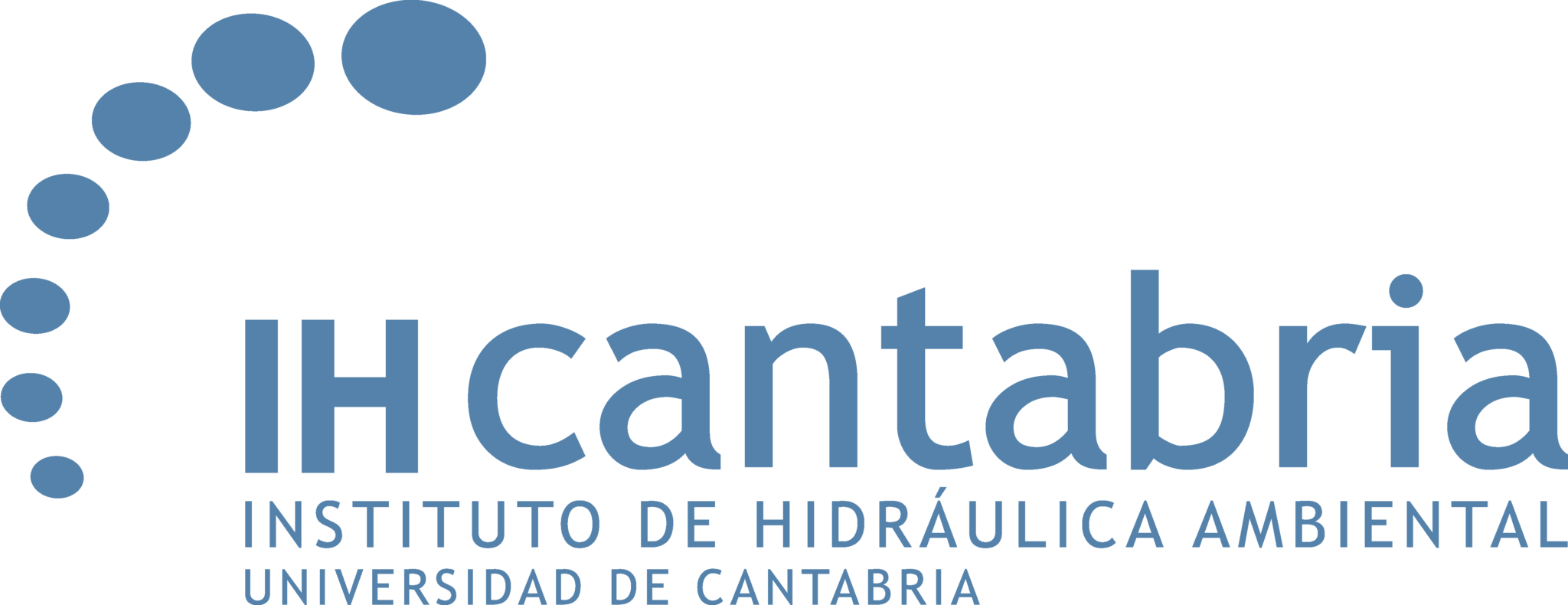JAVIER LÓPEZ LARA
Head of Climate Risks, Adaptation and Resilience Group
Main Researcher
+34 942 20 16 16 Ext. 56205
Biography
Javier López Lara is Full Professor at the Universidad de Cantabria (UC). He is also the head of Climate Risks, Adaptation and Resilience Group of IHCantabria. Javier graduated as a Civil Engineer (1998) from the Universidad de Cantabria and obtained his PhD in 2002 from the same university. After holding various positions as a researcher at the Universidad de Cantabria and at Cornell University (USA), he obtained a position as “Ramón y Cajal” (2008-2012) in the Department of Water Science and Technology at UC, where he is currently a sub-director.
Javier has developed his research in the field of wave hydrodynamics, specializing also surf zone hydrodynamics and wave-structure interactions, using both experimental and numerical methods, the latter focusing mainly on CFD codes. In recent years he has extended his research to environmental flows, hydrodynamics of aquatic ecosystems and hydraulics. Through his research he was awarded the Modesto Vigueras Prize 2004, granted by the Technical Association of Ports and Coastal Areas, Spanish branch of the International Ports Association (PIANC) and the International Research Prize “Paepe-Willems” (PIANC), in 2005, granted to researchers under 40 years old.
Javier is currently Principal Investigator in several projects funded by the Spanish Scince Ministry, competitive projects financed by the Spanish Innnovation Ministry and different EU Proyects. He has published 52 SCI research papers and 8 book chapters. He has advised 45 MSc and bachelor thesis and 12 PhD dissertations. He has coauthored more than one hundred national and international congress communications.
RESEARCH LINES
Numerical modeling of the interaction of waves with coastal and offshore structures.
Hydrodynamic modeling of wave interaction with vegetation.
Probabilistic design of infrastructures.
Surf zone Hydrodynamics.
Infragravity wave transformation in the surf zone and wave run-up in coastal areas.
pUBLiCACIOnES
Sabeti, R., Heidarzadeh, M., Romano, A., Barajas, G., Lara, J.L. (2024) Three-Dimensional Simulations of Subaerial Landslide-Generated Waves: Comparing OpenFOAM and FLOW-3D HYDRO Models. Pure and Applied Geophysics. DOI: 10.1007/s00024-024-03443-x
Lucio, D., Lara, J.L.., Tomas, A., Losada, I.J. (2024) Projecting compound wave and sea-level events at a coastal structure site under climate change. Coastal Engineering, 185, art. no. 104380.
Khan, M.A., Barajas, G., Gaeta, M.G., Lara, J.L., Archetti, R. (2024) Hydrodynamic analysis and optimization of a floating wave energy converter with moonpool using OpenFOAM® Applied Ocean Research, 2024, 142, 103847
Lopez-Arias F., Maza M., Lara J.L., Losada I. (2023) A new predictive tool for modeling wave attenuation produced by saltmarshes in SWAN based on standing biomass. Coastal Engineering, 185, art. no. 104380.
Fischione P., Celli D., Pasquali D., Barajas, G. Di Paolo, B., Lara, J.L. (2023) Inside a Beach Drainage System: A Three-Dimensional Modeling. International Journal of Offshore and Polar Engineering 33(2):196-203
Romano-Moreno, E., Diaz-Hernandez, G., Tomás, A., Lara, J.L. (2023) Multivariate assessment of port operability and downtime based on the wave-induced response of moored ships at berths. Ocean Engineering, 283, art. no. 115053.
Stagnitti, M., Lara, J.L., Musumeci, R.E., Foti, E. (2023) Numerical modeling of wave overtopping of damaged and upgraded rubble-mound breakwaters. Ocean Engineering, 280, art. no. 114798, .
Romano-Moreno, E., Diaz-Hernandez, G., Tomás, A., Lara, J.L. (2023) Multimodal harbor wave climate characterization based on wave agitation spectral types. Coastal Engineering, 180, art. no. 104271.
Batlle Martin, M., Pinon, G., Barajas, G., Lara, J.L., Reveillon, J. (2023) Computations of pressure loads on an oscillating water column with experimental comparison for random waves. Coastal Engineering, 179, art. no. 104228.
Stagnitti, M., Lara, J.L., Musumeci, R.E., Foti, E. (2023) Assessment of the variation of failure probability of upgraded rubble-mound breakwaters due to climate change. Frontiers in Marine Science, 9, art. no. 986993.
Maza, M., Lara, J.L., Losada, I.J. (2022) A paradigm shift in the quantification of wave energy attenuation due to saltmarshes based on their standing biomass. Scientific Reports, 12 (1), art. no. 13883.
García-Maribona, J., Lara, J.L., Maza, M., Losada, I.J. (2022) Analysis of the mechanics of breaker bar generation in cross-shore beach profiles based on numerical modelling. Coastal Engineering, 177, art. no. 104172.
Romano-Moreno, E., Tomás, A., Diaz-Hernandez, G., Lara, J.L., Molina, R., García-Valdecasas, J. (2022) A Semi-Supervised Machine Learning Model to Forecast Movements of Moored Vessels. Journal of Marine Science and Engineering, 10 (8), art. no. 1125.
LG, G., Maza, M., Garcia-Maribona, J., Lara, J.L., Suzuki, T., Argemi Cierco, M., Paul, M., Folkard, A.M., Balke, T. (2022) Living on the edge: How traits of ecosystem engineers drive bio-physical interactions at coastal wetland edges. Advances in Water Resources, 166, art. no. 104257, .
Romano-Moreno, E., Diaz-Hernandez, G., L. Lara, J., Tomás, A., F. Jaime, F. (2022) Wave downscaling strategies for practical wave agitation studies in harbours (2022) Coastal Engineering, 175, art. no. 104140.
Watanabe, M., Arikawa, T., Kihara, N., Tsurudome, C., Hosaka, K., Kimura, T., Hashimoto, T., Ishihara, F., Shikata, T., Morikawa, D.S., Makino, T., Asai, M., Chida, Y., Ohnishi, Y., Marras, S., Mukherjee, A., Cajas, J.C., Houzeaux, G., Paolo, B.D., Lara, J.L., Barajas, G., Losada, Í.J., Hasebe, M., Shigihara, Y., Asai, T., Ikeya, T., Inoue, S., Matsutomi, H., Nakano, Y., Okuda, Y., Okuno, S., Ooie, T., Shoji, G., Tateno, T. (2022) Validation of tsunami numerical simulation models for an idealized coastal industrial site. Coastal Engineering Journal, 64 (2), pp. 302-343.
Diaz-Hernandez, G., Rodríguez Fernández, B., Romano-Moreno, E., L. Lara, J. (2021) An improved model for fast and reliable harbour wave agitation assessment. Coastal Engineering, 170, art. no. 104011
García-Maribona, J., Lara, J.L., Maza, M., Losada, I.J. (2021) An efficient RANS numerical model for cross-shore beach processes under erosive conditions. Coastal Engineering, 170, art. no. 103975.
Mendes, L.S., Lara, J.L., Viseu, M.T. (2021) Do the volume-of-fluid and the two-phase Euler compete for modeling a spillway aerator? Water (Switzerland), 13 (21), art. no. 3092, .
Maza, M., Lara, J.L., Losada, I.J. (2021) Predicting the evolution of coastal protection service with mangrove forest age. Coastal Engineering, 168, art. no. 103922.
Carvalho, R.F., Santos, J.A., Ojeda, G.B., Beg, N.A., Lopes, P.M., Fortes, J.C., Lara, J.L. (2021) Experimental and numerical simulations of oblique extreme wave conditions in front of a breakwater’s trunk and round head Journal of Integrated Coastal Zone Management, 21 (2), pp. 73-85.
Mendes, L.S., Lara, J.L., Viseu, M.T. (2021) Is the volume-of-fluid method coupled with a sub-grid bubble equation efficient for simulating local and continuum aeration? Water (Switzerland), 13 (11), art. no. 1535,
Valela, C., Nistor, I., Rennie, C.D., Lara, J.L., Maza, M. (2021) Hybrid Modeling for Design of a Novel Bridge Pier Collar for Reducing Scour. Journal of Hydraulic Engineering, 147 (5), art. no. 04021012
Di Paolo, B., Lara, J.L., Barajas, G., Losada, Í.J. (2021) Wave and structure interaction using multi-domain couplings for Navier-Stokes solvers in OpenFOAM®. Part I: Implementation and validation. Coastal Engineering, 164, art. no. 103799.
Di Paolo, B., Lara, J.L., Barajas, G., Losada, Í.J. (2021) Waves and structure interaction using multi-domain couplings for Navier-Stokes solvers in OpenFOAM®. Part II: Validation and application to complex cases. Coastal Engineering, 164, art. no. 103818
Castellino, M., Romano, A., Lara, J.L., Losada, I.J., De Girolamo, P. (2021) Confined-crest impact: Forces dimensional analysis and extension of the Goda’s formulae to recurved parapets. Coastal Engineering, 163, art. no. 103814
Blanco-Aguilera, R., Lara, J.L., Barajas, G., Tejero, I., Díez-Montero, R. (2020) Hydrodynamic optimization of multi-environment reactors for biological nutrient removal: A methodology combining computational fluid dynamics and dimensionless indexes. Chemical Engineering Science, 224, art. no. 115766.
Lucio, D., Tomás, A., Lara, J.L., Camus, P., Losada, I.J. (2020) Stochastic modeling of long-term wave climate based on weather patterns for coastal structures applications. Coastal Engineering, 161, art. no. 103771.
Di Lauro, E., Maza, M., Lara, J.L., Losada, I.J., Contestabile, P., Vicinanza, D. (2020) Advantages of an innovative vertical breakwater with an overtopping wave energy converter. Coastal Engineering, 159, art. no. 103713.
Romano, A., Lara, J.L., Barajas, G., Di Paolo, B., Bellotti, G., Di Risio, M., Losada, I.J., De Girolamo, P. (2020) Tsunamis Generated by Submerged Landslides: Numerical Analysis of the Near-Field Wave Characteristics. Journal of Geophysical Research: Oceans, 125 (7), art. no. e2020JC016157.
Blanco-Aguilera, R., Lara, J.L., Barajas, G., Tejero, I., Diez-Montero, R. (2020) CFD simulation of a novel anaerobic-anoxic reactor for biological nutrient removal: Model construction, validation and hydrodynamic analysis based on OpenFOAM®. Chemical Engineering Science, 215, art. no. 115390.
Lara, J.L., Maza, M. (2020) Selected papers from Coastlab18 conference. Journal of Marine Science and Engineering, 8 (4), art. no. 250,
Lara, J.L., Lucio, D., Tomas, A., Di Paolo, B., Losada, I.J. (2019) High-resolution time-dependent probabilistic assessment of the hydraulic performance for historic coastal structures: Application to Luarca Breakwater. Philosophical Transactions of the Royal Society A: Mathematical, Physical and Engineering Sciences, 377 (2155), art. no. 20190016, .
Aniel-Quiroga, Í., Vidal, C., Lara, J.L., González, M. (2019) Pressures on a rubble-mound breakwater crown-wall for tsunami impact. Coastal Engineering, 152, art. no. 103522.
Ruju, A., Lara, J.L., Losada, I.J. (2019) Numerical Assessment of Infragravity Swash Response to Offshore Wave Frequency Spread Variability. Journal of Geophysical Research: Oceans, 124 (9), pp. 6643-6657.
Maza, M., Lara, J.L., Losada, I.J. (2019) Experimental analysis of wave attenuation and drag forces in a realistic fringe Rhizophora mangrove forest. Advances in Water Resources, 131, art. no. 103376.
Vicinanza, D., Lauro, E.D., Contestabile, P., Gisonni, C., Lara, J.L., Losada, I.J. (2019) Review of Innovative Harbor Breakwaters for Wave-Energy Conversion. Journal of Waterway, Port, Coastal and Ocean Engineering, 145 (4), art. no. 03119001.
Di Lauro, E., Lara, J.L., Maza, M., Losada, I.J., Contestabile, P., Vicinanza, D. (2019) Stability analysis of a non-conventional breakwater for wave energy conversion. Coastal Engineering, 145, pp. 36-52.
Garzon, J.L., Maza, M., Ferreira, C.M., Lara, J.L., Losada, I.J. (2019) Wave Attenuation by Spartina Saltmarshes in the Chesapeake Bay Under Storm Surge Conditions. Journal of Geophysical Research: Oceans, 124 (7), pp. 5220-5243.
Aniel-Quiroga, Í., Vidal, C., Lara, J.L., González, M., Sainz, Á. (2018) Stability of rubble-mound breakwaters under tsunami first impact and overflow based on laboratory experiments. Coastal Engineering, 135, pp. 39-54.
Maza, M., Lara, J.L., Losada, I.J. (2016) Solitary wave attenuation by vegetation patches. Advances in Water Resources, 98, pp. 159-172.
Rueda, A., Gouldby, B., Méndez, F.J., Tomás, A., Losada, I.J., Lara, J.L., Díaz-Simal, P. (2016) The use of wave propagation and reduced complexity inundation models and metamodels for coastal flood risk assessment. Journal of Flood Risk Management, 9 (4), pp. 390-401.
Losada, I.J., Lara, J.L., del Jesus, M. (2016) Modeling the interaction of water waves with porous coastal structures. Journal of Waterway, Port, Coastal and Ocean Engineering, 142 (6), art. no. 03116003, .
Inverno, J., Neves, M.G., Didier, E., Lara, J.L. (2016) Numerical simulation of wave interacting with a submerged cylinder using a 2D RANS model(2016) Journal of Hydro-Environment Research, 12, pp. 1-15.
Tomás, A., Méndez, F.J., Medina, R., Jaime, F.F., Higuera, P., Lara, J.L., Ortiz, M.D., Álvarez de Eulate, M.F. (2016) A methodology to estimate wave-induced coastal flooding hazard maps in Spain. Journal of Flood Risk Management, 9 (3), pp. 289-305.
Vílchez, M., Clavero, M., Lara, J.L., Losada, M.A. (2016) A characteristic friction diagram for the numerical quantification of the hydraulic performance of different breakwater types. Coastal Engineering, 114, pp. 86-98.
Diaz-Hernandez, G., Lara, J.L., Losada, I.J. (2016) Extended long wave hindcast inside port solutions to minimize resonance. Journal of Marine Science and Engineering, 4 (1), art. no. 9.
Losada, I.J., Maza, M., Lara, J.L. (2016) A new formulation for vegetation-induced damping under combined waves and currents. Coastal Engineering, 107, pp. 1-13.
Lara, J.L., Maza, M., Ondiviela, B., Trinogga, J., Losada, I.J., Bouma, T.J., Gordejuela, N. (2016) Large-scale 3-D experiments of wave and current interaction with real vegetation. Part 1: Guidelines for physical modeling. Coastal Engineering, 107, pp. 70-83.
Maza, M., Lara, J.L., Losada, I.J., Ondiviela, B., Trinogga, J., Bouma, T.J. (2015) Large-scale 3-D experiments of wave and current interaction with real vegetation. Part 2: Experimental analysis. Coastal Engineering, 106, pp. 73-86.
Iturrioz, A., Guanche, R., Lara, J.L., Vidal, C., Losada, I.J. (2015) Validation of OpenFOAM® for Oscillating Water Column three-dimensional modeling. Ocean Engineering, 107, pp. 222-236.
Higuera, P., Losada, I.J., Lara, J.L. (2015) Three-dimensional numerical wave generation with moving boundaries. Coastal Engineering, 101, pp. 35-47.
Maza, M., Lara, J.L., Losada, I.J. (2015) Tsunami wave interaction with mangrove forests: A 3-D numerical approach. Coastal Engineering, 98, pp. 33-54.
Burcharth, H.F., Lykke Andersen, T., Lara, J.L. (2014) Upgrade of coastal defence structures against increased loadings caused by climate change: A first methodological approach. Coastal Engineering, 87, pp. 112-121.
Ruju, A., Lara, J.L., Losada, I.J. (2014) Numerical analysis of run-up oscillations under dissipative conditions. Coastal Engineering, 86, pp. 45-56.
Higuera, P., Lara, J.L., Losada, I.J. (2014) Three-dimensional interaction of waves and porous coastal structures using OpenFOAM®. Part I: Formulation and validation. Coastal Engineering, 83, pp. 243-258.
Higuera, P., Lara, J.L., Losada, I.J. (2014) Three-dimensional interaction of waves and porous coastal structures using OpenFOAM®. Part II: Application. Coastal Engineering, 83, pp. 259-270.
Ondiviela, B., Losada, I.J., Lara, J.L., Maza, M., Galván, C., Bouma, T.J., van Belzen, J. (2014) The role of seagrasses in coastal protection in a changing climate. Coastal Engineering, 87, pp. 158-168.
Bouma, T.J., van Belzen, J., Balke, T., Zhu, Z., Airoldi, L., Blight, A.J., Davies, A.J., Galvan, C., Hawkins, S.J., Hoggart, S.P.G., Lara, J.L., Losada, I.J., Maza, M., Ondiviela, B., Skov, M.W., Strain, E.M., Thompson, R.C., Yang, S., Zanuttigh, B., Zhang, L., Herman, P.M.J. (2014) Identifying knowledge gaps hampering application of intertidal habitats in coastal protection: Opportunities & steps to take. Coastal Engineering, 87, pp. 147-157.
Maza, M., Lara, J.L., Losada, I.J. (2013) A coupled model of submerged vegetation under oscillatory flow using Navier-Stokes equations. Coastal Engineering, 80, pp. 16-34.
Higuera, P., Lara, J.L., Losada, I.J. (2013) Simulating coastal engineering processes with OpenFOAM®. Coastal Engineering, 71, pp. 119-134.
Higuera, P., Lara, J.L., Losada, I.J. (2013) Realistic wave generation and active wave absorption for Navier-Stokes models. Application to OpenFOAM®. Coastal Engineering, 71, pp. 102-118.
Higuera, P., Del Jesus, M., Lara, J.L., Losada, I.J., Guanche, Y., Barajas, G. (2013)Numerical simulation of three-dimensional breaking waves on a gravel slope using a two-phase flow Navier-Stokes model. Journal of Computational and Applied Mathematics, 246, pp. 144-152.
Ruju, A., Lara, J.L., Losada, I.J. (2012) Radiation stress and low-frequency energy balance within the surf zone: A numerical approach. Coastal Engineering, 68, pp. 44-55.
Del Jesus, M., Lara, J.L., Losada, I.J. (2012) Numerical modeling of tsunami waves interaction with porous and impermeable vertical barriers. Journal of Applied Mathematics, 2012, art. no. 263839.
del Jesus, M., Lara, J.L., Losada, I.J. (2012) Three-dimensional interaction of waves and porous coastal structures. Part I: Numerical model formulation. Coastal Engineering, 64, pp. 57-72.
Lara, J.L., del Jesus, M., Losada, I.J. (2012) Three-dimensional interaction of waves and porous coastal structures. Part II: Experimental validation. Coastal Engineering, 64, pp. 26-46.
Palomar, P., Lara, J.L., Losada, I.J. (2012) Near field brine discharge modeling part 2: Validation of commercial tools. Desalination, 290, pp. 28-42.
Palomar, P., Lara, J.L., Losada, I.J., Rodrigo, M., Alvárez, A. (2012) Near field brine discharge modelling part 1: Analysis of commercial tools. Desalination, 290, pp. 14-27.
Stratigaki, V., Manca, E., Prinos, P., Losada, I.J., Lara, J.L., Sclavo, M., Amos, C.L., Cáceres, I., Sánchez-Arcilla, A. (2011) Large-scale experiments on wave propagation over Posidonia oceánica. Journal of Hydraulic Research, 49 (SUPPL.1), pp. 31-43.
Lara, J.L., Losada, I.J., Maza, M., Guanche, R. (2011) Breaking solitary wave evolution over a porous underwater step. Coastal Engineering, 58 (9), pp. 837-850.
Lara, J.L., Ruju, A., Losada, I.J. (2011) Reynolds averaged Navier-Stokes modelling of long waves induced by a transient wave group on a beach. Proceedings of the Royal Society A: Mathematical, Physical and Engineering Sciences, 467 (2129), pp. 1215-1242.
Torres-Freyermuth, A., Lara, J.L., Losada, I.J. (2010) Numerical modelling of short- and long-wave transformation on a barred beach. Coastal Engineering, 57 (3), pp. 317-330.
Guanche, R., Losada, I.J., Lara, J.L. (2009) Numerical analysis of wave loads for coastal structure stability. Coastal Engineering, 56 (5-6), pp. 543-558.
Lara, J.L., Losada, I.J., Guanche, R. (2008) Wave interaction with low-mound breakwaters using a RANS model. Ocean Engineering, 35 (13), pp. 1388-1400.
Losada, I.J., Lara, J.L., Guanche, R., Gonzalez-Ondina, J.M. (2008) Numerical analysis of wave overtopping of rubble mound breakwaters. Coastal Engineering, 55 (1), pp. 47-62.
Liu, P.L.-F., Park, Y.S., Lara, J.L. (2007) Long-wave-induced flows in an unsaturated permeable seabed. Journal of Fluid Mechanics, 586, pp. 323-345.
Torres-Freyermuth, A., Losada, I.J., Lara, J.L. (2007) Modeling of surf zone processes on a natural beach using Reynolds-Averaged Navier-Stokes equations. Journal of Geophysical Research: Oceans, 112 (9), art. no. C09014.
Lara, J.L., Losada, I.J., Liu, P.L.-F. (2006) Breaking waves over a mild gravel slope: Experimental and numerical analysis (2006) Journal of Geophysical Research: Oceans, 111 (11), art. no. C11019.
Lara, J.L., Garcia, N., Losada, I.J. (2006) RANS modelling applied to random wave interaction with submerged permeable structures. Coastal Engineering, 53 (5-6), pp. 395-417.
Losada, I.J., Lara, J.L., Christensen, E.D., Garcia, N. (2005) Modelling of velocity and turbulence fields around and within low-crested rubble-mound breakwaters. Coastal Engineering, 52 (10-11), pp. 887-913.
Garcia, N., Lara, J.L., Losada, I.J. (2004) 2-D numerical analysis of near-field flow at low-crested permeable breakwaters. Coastal Engineering, 51 (10), pp. 991-1020.
Lara, J., Cowen, E., Sou, I. (2002) A depth-of-field limited particle image velocimetry technique applied to oscillatory boundary layer flow over a porous bed. Experiments in Fluids, 33 (1), pp. 47-53.




